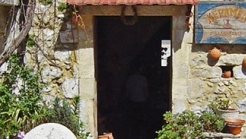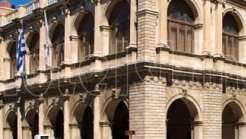

Greece
740 metres up on the north face of Mount Psiloritis in prefecture of Rethymno lies proudly Anogia. A village with a history that is powerful and tragic at the same time. Burned by the Turks in 1822 and by the Germans in 1944,this village has a heroic story to tell.
Anogia
740 metres up on the north face of Mount Psiloritis in prefecture of Rethymno lies proudly Anogia.
A village with a history that is powerful and tragic at the same time.
History of Anogia
Burned by the Turks in 1822 and by the Germans in 1944,this village has a heroic story to tell.
The holocaust
Highlight of the Resistance of the struggling people of Anogia was the destruction and flattening of the village. In August 1944 it took place the third holocaust of Anogia (1822, 1867, 1944). It began August 13 and lasted until the end of that month.
During German possession Anogia emerged as one of the finest examples of continuous resistance presence. Anogia distinguished the internal unity, their organization, their discipline and determination.
The first visit of the Germans in Anogia will take place in the winter of 1942.
But despite executions and brutal actions against the local population people of Anogia never give up.
13 of August 1944,three German battalions will arrive 5km from Anogia. The Anogians warned the people and all men in the village fled to the mountains taking with them many women and children.Germans invade the village from several directions and the disaster began.They razed the village by setting it on fire and blowing it up. Around 2500 women and children who had survive forced to abandon the area seeking for refuge.
Nowadays
The birthplace of the famous Greek singers Nikos Xylouris,Psarantonis,Vasilis Skoulas and Giorgos Xylouris Anogia considered the epicenter of contemporary Cretan civilization.
The air is mountain-fresh, the local Raki and food genuinely good and made with local ingredients, olive oil, wheat, wine, honey, herbs and aromatic plants.Top tastes are “ofto”,gamopilafo and cheese. The cuisine of Anogeia is typical of the traditional Cretan one. The wealth and the quality of the products of the island over the centuries had as a result a cuisine with unique taste and freshness.
The square of Agios Georgios is a splendid exhibition of local life and a good place to stop for coffee, buy local cheese and visit the small church of the same name.
Traditional Cretan music can be enjoyed at the village in the concerts which are held in the open theatre during summer, as well as in festivals the two first weeks of August. Moreover, the cultural club of Anogia organises cultural nights and attracts visitors not only from Crete but from other parts of Greece. Don't miss Yakinthia, every year in late July, take place in the stone theater of St.Hyakinth, which has been built at an altitude of 1260 meters on Psiloritis, in a unique place, full of old oak trees. These cultural events are considered to be one of the most important cultural festivals in Greece and as a reference point of cultural exchange in the Mediterranean.
To appreciate Anogia take time to walk, stop for coffee or drink, eat and allow any kindness or generosity that might be offered you, to quench the thirst for offering hospitality that is a hallmark of Crete and has its source in Anogia.

__list_246_139_c1.jpg)
The Military Museum of Rethymno is situated on the southern tip of the Municipal district of the village of Chromonastery , 11klm southeast of Rethymno and on the northern rims of mountain Vrysinas, at an altitude of 360m. From a historical viewpoint, Chromonastery is one of the most remarkable hist


Follow us on the European E4 path crosses Crete from one end to the other, offering to hikers really amazing experiences.


Loggia was the Club of Venetian and Cretan rulers of the Kingdom of Crete. Today it accommodates the Municipality of Heraklion. The building that is visible today it is build in the time of Francis Morosini in 1628. Winged lion of The Most Serene Republic of Adriatic is everywhere.
1039 Ε 6061 01515 00